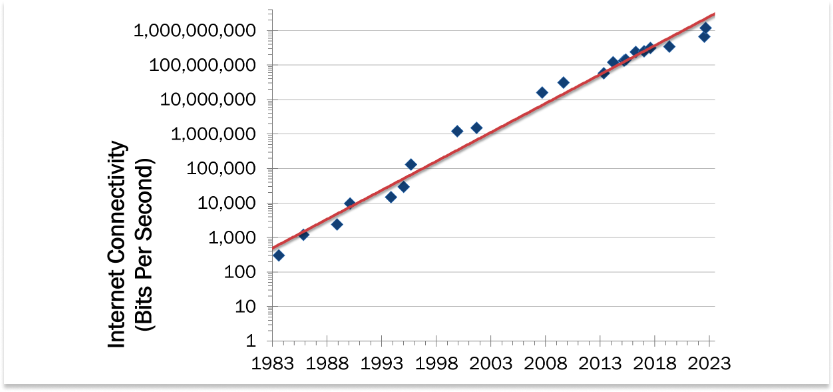09.03.23: Curve Dependent
先发可能并不意味着优势:可能会错失技术的关键突破,而停留在一个早熟的优化阶段上。

本周的主题是 Curve Dependent 曲线依赖。
看下面这张图,关于过去 20 年中,互联网的数据传输速率如何从每秒不到 1000 比特增长为现在的每秒十亿比特以上。

这张图很有力量,不仅仅是因为它展示了一张技术进步的图景,更是因为我们可以把这条曲线商业机会结合起来。投资人 Chris Paik 讲道:
One thing that I think is underexplored is the impact of data transfer speeds as actual why now reasons for companies existing. Let's look at mobile social networks and the order that they were founded in; Twitter 2006, Instagram 2010, Snapchat 2011, maybe most recently TikTok named Musical.ly in 2014.
我认为尚未充分探讨的一件事是数据传输速度的影响作为公司存在的实际原因。让我们看看移动社交网络及其创建的顺序; Twitter 2006 年、Instagram 2010 年、Snapchat 2011 年,也许最近的是 2014 年命名为 Musical.ly 的 TikTok。
对于那些或许不大清楚 Bits Per Second 的含义的读者(其实也包括我自己),2003 年,互联网每秒可以传输 1 百万比特数据,大概相当于 125k 字节;而到了 2013 年,这个数字增长了一个数量级,就是达到了每秒兆字节的速率,再过十年,又增长了两个数量级,达到了每秒百兆字节的速率——这时候你可能会注意到,这张图的纵轴具有误导性:它的刻度是指数级增长的。
换算为字节单位后,我们都能够估算从 1983 年到 2023 年的 40 年时间里,互联网发生了怎样的变化。在 Paik 的回溯中,每一代社交媒体应用的出现时机都刚好在它们所代表的内容形态可以在一秒以内被传输到消费者面前的时间点上。
Instagram 和 Snapchat 都曾经出现在 Platform Thinking + 过去的 newsletter 中。我花费了大量的篇幅追溯它们的创业故事和产品演进,在传记、财报和评论文章之中沉迷太久,以至于忘记了它们和早先的 Twitter 以及后来的 TikTok 并非同代竞争,它们诞生于曲线的不同阶段,而这些阶段并非如我们的日历一般是均匀线性分布的。
